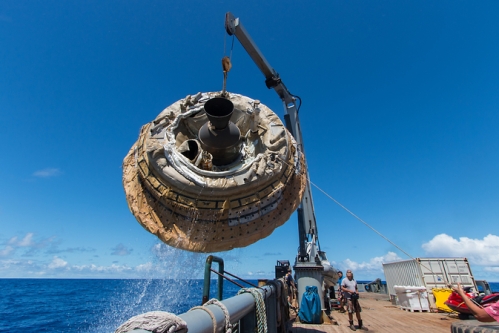
(LDSD being recovered from the ocean – Photo Credit: NASA/JPL – Caltech)
The first test flight of NASA’s Low-Density Supersonic Decelerator (LDSD) has been deemed a success, despite the craft suffering a ‘hard landing’ in the ocean when its descent parachute failed to fully deploy.
The craft, attached to a high-altitude balloon, launched at 6:45 p.m. GMT on June 28th from the U.S. Navy’s Pacific Missile Range Facility in Kauai, Hawaii.
Upon travelling to a height of 120,000 feet, the LDSD test vehicle detached from its balloon and began a period of powered flight. Thrusters propelled the vehicle at supersonic speeds higher into Earth’s stratosphere, reaching 160,000ft.
Initial measurements of the craft showed that it successfully flew its flight test profile as planned, and released its two landing technologies.
As the vehicle prepared to drop back to Earth, its Supersonic Inflatable Aerodynamic Decelerator (SIAD), a large, doughnut-shaped deceleration technology, deployed. The SIAD increased the diameter of the vehicle, creating atmospheric drag which dramatically slowed the craft down from Mach 4 (four times the speed of sound) to Mach 2.5 however the craft’s enormous Supersonic Disk Sail Parachute emerged tangled.
Imagery downlinked in real-time from the test vehicle indicated that its parachute did not fully inflate, causing LDSD to experience a rather bumpy landing.
The vehicle splashed down in the Pacific Ocean at approximately 9:35 p.m. GMT. Luckily, despite the loss of a parachute, LDSD survived its reentry and was recovered in one piece. The test vehicle hardware, black box data recorder and parachute were all retrieved later in the day by a recovery vessel.
 (Photo Credit: NASA/JPL-Caltech)
(Photo Credit: NASA/JPL-Caltech)
“We are thrilled about yesterday’s test,” said Mark Adler, project manager for LDSD at NASA’s Jet Propulsion Laboratory. “The test vehicle worked beautifully, and we met all of our flight objectives. We have recovered all the vehicle hardware and data recorders and will be able to apply all of the lessons learned from this information to our future flights”.
This test was the first of three which are planned for the LDSD project. While this initial test was designed to determine the flying ability of the vehicle, testing the two new landing technologies was considered as a bonus. The landing technologies will be specifically tested in the next two flights.
“Because our vehicle flew so well, we had the chance to earn ‘extra credit’ points with the Supersonic Inflatable Aerodynamic Decelerator [SIAD],” said Ian Clark, principal investigator for LDSD at JPL. “All indications are that the SIAD deployed flawlessly, and because of that, we got the opportunity to test the second technology, the enormous supersonic parachute, which is almost a year ahead of schedule.”
 (LDSD travels back to shore for analysis – Photo Credit: NASA/JPL-Caltech)
(LDSD travels back to shore for analysis – Photo Credit: NASA/JPL-Caltech)
In order to get larger payloads to Mars, cutting-edge technologies like LDSD are critical. Among other applications, this new space technology will enable the delivery of supplies and materials which will be needed for long-duration human missions to the Red Planet.
Despite like the parachute not deploying fully, Nasa deemed the mission a success.
 (The craft preparing for flight – Photo Credit: NASA/JPL-Caltech)
(The craft preparing for flight – Photo Credit: NASA/JPL-Caltech)
“This entire effort was just fantastic work by the whole team and is a proud moment for NASA’s Space Technology Mission Directorate,” said Dorothy Rasco, deputy associate administrator for the Space Technology Mission Directorate at NASA Headquarters in Washington. “This flight reminds us why NASA takes on hard technical problems, and why we test – to learn and build the tools we will need for the future of space exploration. Technology drives exploration, and yesterday’s flight is a perfect example of the type of technologies we are developing to explore our solar system.”
To learn more information about the LDSD space technology demonstration mission, click here.
[Video courtesty of SpaceVids.tv]